In the summer of 1954, wealthy citrus magnate, John A. Snively, Jr and his wife May (these were their real names, not inventions of some hack Hollywood screenwriter), entertained the Shah and Queen of Iran with a sumptuous backyard barbecue.
The queen was enthralled by a particular dish, a green bean casserole. So much so, according to May Snively, that she began pestering the butler to tell her what was in it. After repeated questioning throughout the evening, the exasperated butler snapped, “Listen, lady, it’s just beans and stuff!”
That might have been the end of the matter, except that Mrs. Snively told this story at another gathering at which she served the same casserole. In attendance was Cecily Brownstone, the food editor for the Associated Press. Brownstone decided to write about the humorous encounter. So she needed a green bean recipe to go with the article.
She reached out to Campbell’s Soup Company to develop a recipe that would be published in hundreds of daily newspapers across the US. With the addition of a can of condensed mushroom soup, milk, and a can of processed fried onions, the recipe became one of the most popular US Thanksgiving side dishes of all time.
If you’ve been looking down on this veggie due to its association either with the Campbell’s Soup green bean casserole, or based on childhood experiences with a bland plate of overcooked green beans, it’s time for some image rehabilitation!
Getting Creative Beyond Green Bean Casseroles
Green beans have never been the cool kids in the produce section. If you grew up eating only tasteless canned green beans that frankly were more gray than green, I get why you may have written them off.
If you’re a gardener, you may have the “What am I going to do with 30 pounds of ripe green beans?” problem every summer. Even if you’re a fan of green beans, and an accomplished cook, you may have run out of things to do with them.
The good news is, you don’t have to wait until the holidays to eat them. And you don’t have to cook the same old green bean dishes again and again.
Fresh green beans not only taste great, if you know how to season them and not overcook them, they’re also chock full of beneficial nutrients — protein, fiber, vitamins, minerals, and phytochemical antioxidants. Like their more popular dried cousins (black, pinto, kidney, lima, and the rest), fresh green beans convey benefits that, in many populations, translate into longevity gains.
So let’s look at some creative new ways to prepare green beans to bring new life into a relationship that may have gone a bit stale. Whether or not you’re fond of green beans, you’ll find a variety of tips to make them taste better and use them in more interesting ways.
And we’ll end with seven healthy green bean recipes to make any time of year.
Choosing & Storing Green Beans
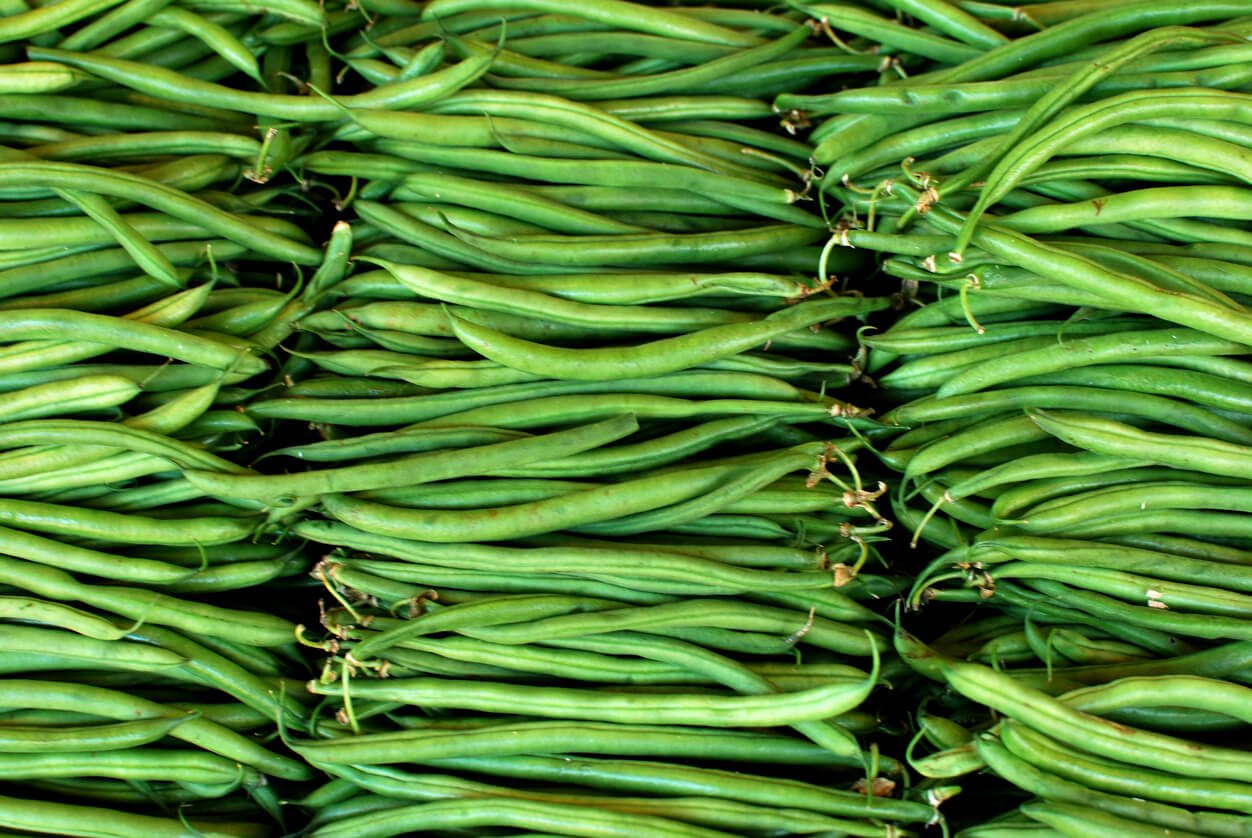
First, let’s make sure you’re sourcing the highest quality green beans you possibly can. Green beans are best when eaten in season (summer or fall), although they freeze well, and in many places, are available fresh year-round thanks to global trade.
Green beans taste best and provide the most nutrients when you eat them fresh or frozen, instead of canned. Best case scenario, you get them freshly picked from a garden — yours or a neighbor’s — or a local farmers market. If you’re growing, look for pole or bush varieties. Pole beans grow upward on poles (surprise!), fences, or trellises, and tend to be more prolific than their bushy counterparts.
Whether shopping or harvesting, pick green beans that are free of brown spots and are firm, uncut, and bright green (or yellow or purple, depending on the variety). You’re looking for vibrant colors, and a loud and satisfying snap when you break one in half.
Don’t store your fresh green beans in the fridge for more than a few days, as they don’t keep well. Ideally, you’ll start prepping them shortly after they enter your kitchen. Prepping typically begins with trimming the tail end — the one that attached the bean to the plant — before cooking or eating. Many recipes call for “topping” the beans as well, which means trimming the non-tail end — but that’s purely an aesthetic preference. In addition to removing their tops, cut off any blemishes and soft spots that may have snuck by you before.
Fresh green beans freeze well, and putting a few pounds in the freezer is a great way to have a year-round supply without needing a can opener. First, blanch the green beans them by dropping them briefly in boiling water — to halt enzyme activity that affects flavor, color, and texture — then plunging them in cold water. Or don’t blanch them, and just place washed and dried beans into freezer-safe containers or bags. They’ll still taste and look fine as long as you use them within a couple of months.
Can You Eat Green Beans Raw?
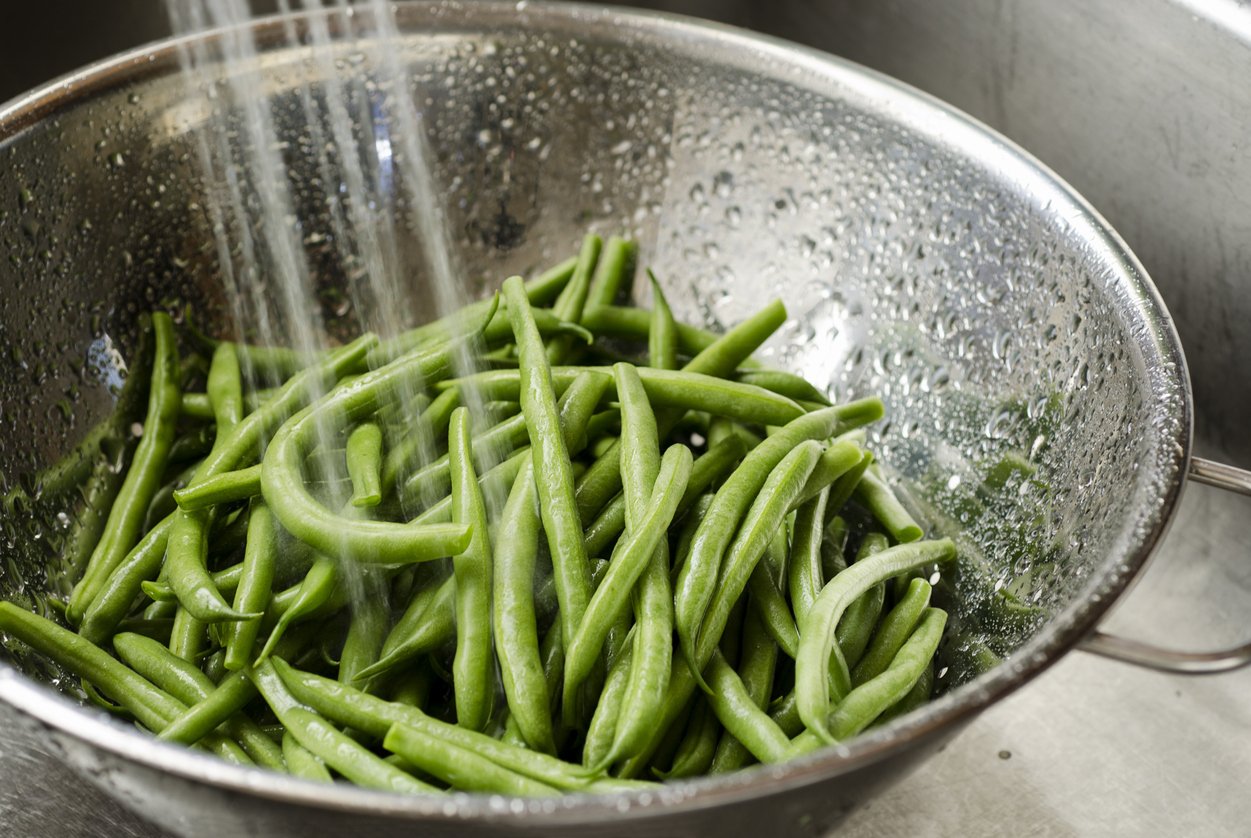
Although they’re typically cooked, you can eat green beans raw, especially as you’re picking them right off the vine or bush. They actually taste sweet and juicy, and the crunch is quite satisfying.
Fresh green beans from the supermarket are a different matter. While you can technically eat them raw (unlike, say, dried kidney beans), there’s no giant benefit in doing so. And there could be a slight safety risk if any of them have sat too long and started on their way to green bean heaven (as in, they’re getting moldy or rotten in spots). Raw green beans are also higher in lectins than cooked ones, which may bother some people.
Wash green beans before eating, especially if you’re eating raw beans that were not grown organically. Green beans are in the middle of the pack when it comes to pesticides, according to the Environmental Working Group, so you won’t find them in either the Dirty Dozen or the Clean Fifteen. (If EWG rebranded their least contaminated produce as the “Clean Nineteen,” green beans would just make the cut.)
Cooking doesn’t affect the content of fat-soluble vitamins like E and K, while it may reduce the amount of water-soluble vitamins like the Bs and C, which end up in the cooking water.
Best Ways to Cook Green Beans
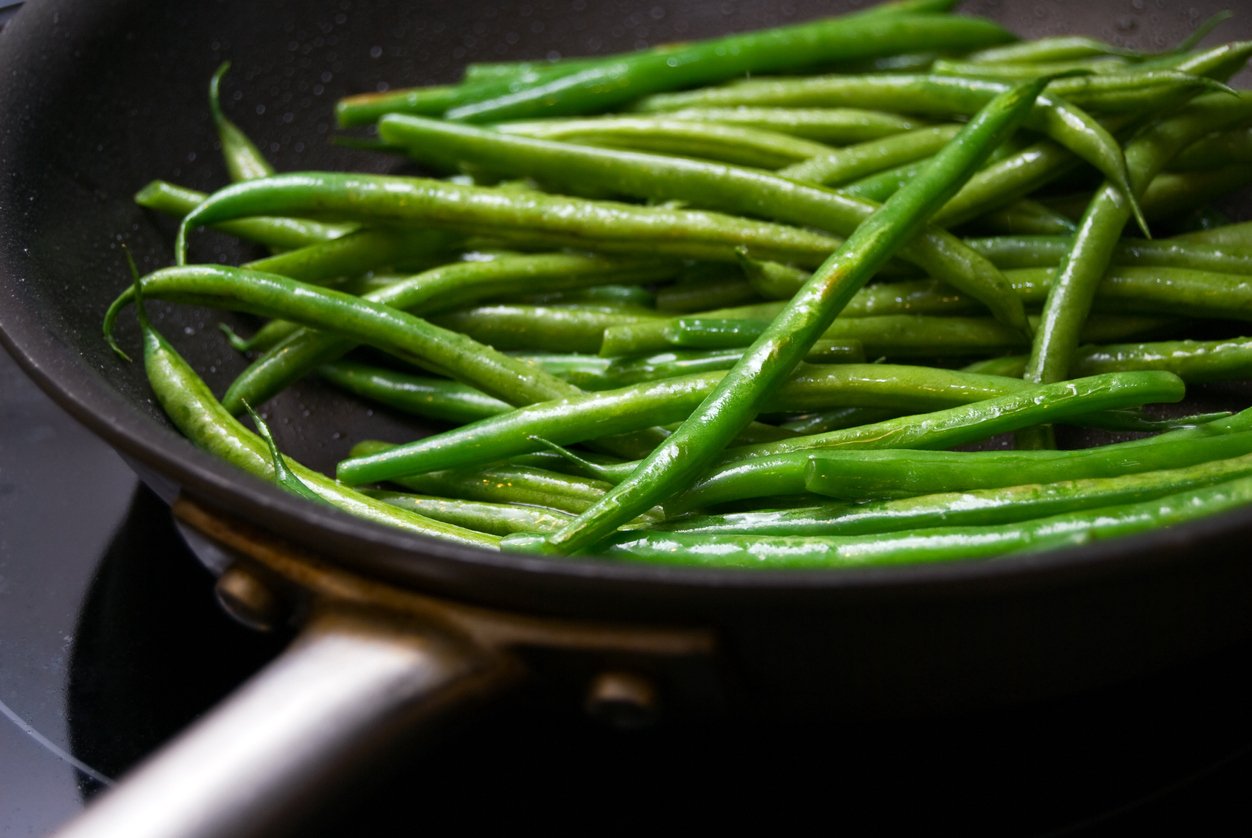
Let’s start this section with the worst way to cook green beans: boil them until they have the same texture as the water they’re in. Of course, this is just my opinion — and that of absolutely everyone who doesn’t enjoy mushy, bland veggies that resemble the color profile of old camouflage fatigues. Overcooking also degrades antioxidants and chlorophyll (hence the faded green color).
Cook green beans just long enough, on the other hand, and you’ll have beans with a crunchy texture and robust taste that’s been described (in a good way) as “grassy.” How long is long enough? If you’re boiling or steaming, stick a fork in after 3–5 minutes and see if they’re ready. (Pro tip: Remember that just because you turn off the burner, doesn’t mean green beans will stop cooking. And whatever you do, never, ever leave well-cooked green beans sitting in nearly boiling water, without a timer set, while you check your Twitter feed.)
After they’re cooked the optimal amount, you can preserve their bright green hue by plunging them briefly into cold water. If you’re going to dress the beans later, wait to add acidic dressings like vinegar until you’re ready to serve them to preserve their color.
In addition to boiling and steaming, stir-frying green beans is another way to cook green beans quickly to preserve their flavor, color, and nutritional profile. Microwaving and pressure cooking green beans also appear to enhance the concentrations of particular nutrients. And the sous vide method, which involves vacuum sealing food in glass jars or plastic bags and cooking it in low-temperature water for a long time, can also preserve water-soluble nutrients like vitamin C. However, heating in plastic can release harmful compounds into the food, so if you decide to sous vide, here’s how to do it without plastic.
You can also always just throw your chopped green beans into soups and stews. Yes, they’ll get soft and lose color, but they will contribute their flavor and nutrients to the rest of the dish.
Creative Ways to Use Green Beans
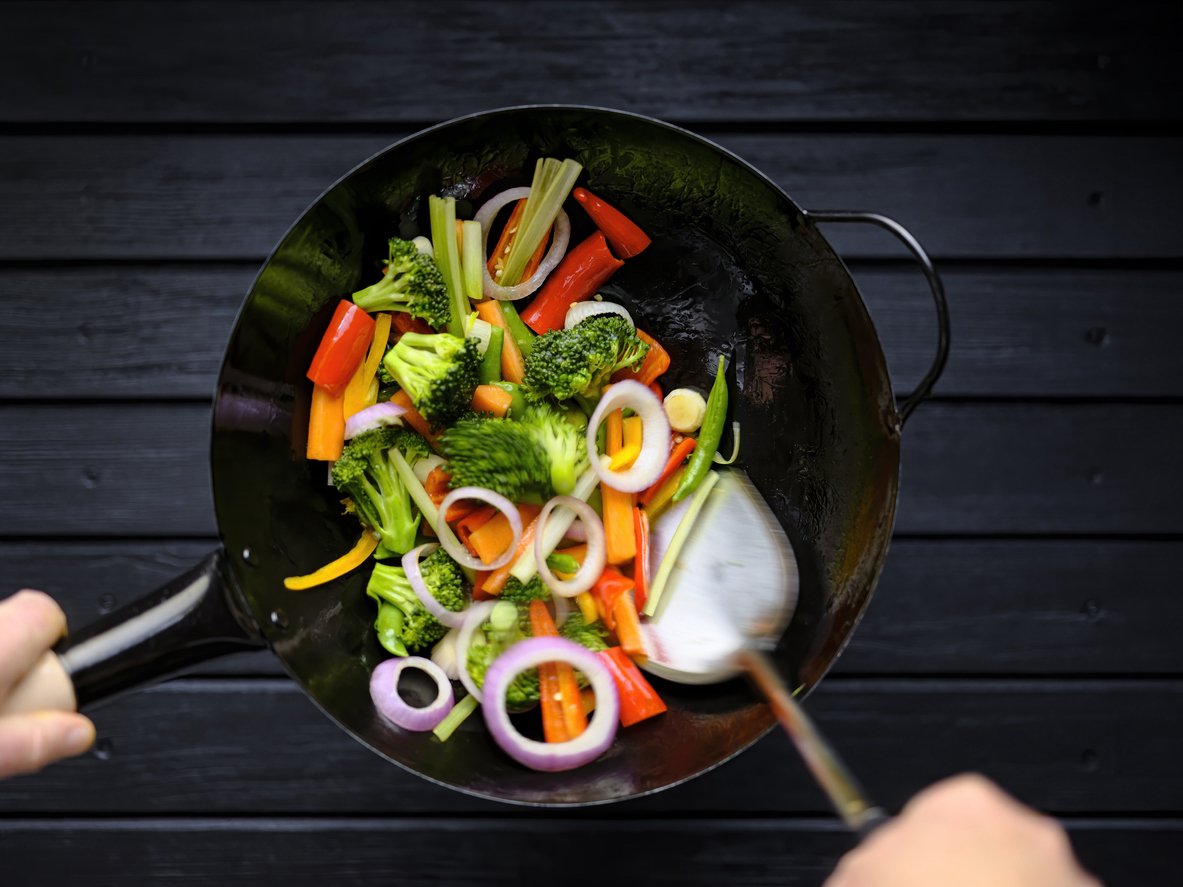
Green beans star in many a side dish, especially as part of holiday meals, but they’re a much more versatile veggie than they get credit for. You can have green bean appetizers, side dishes, snacks, or entrées.
Here’s a short list of green bean ideas to spark your creativity:
- Add cooked green beans to a raw salad
- Turn them into baked, crispy fries and serve them with a dipping sauce
- Include them in soups, stews, and curries
- Toss green beans into grain bowls and stir-fries
- Use them in pasta dishes
- Add them to casseroles and freezer meals
- Pickle or ferment them
How to Season Green Beans in Recipes
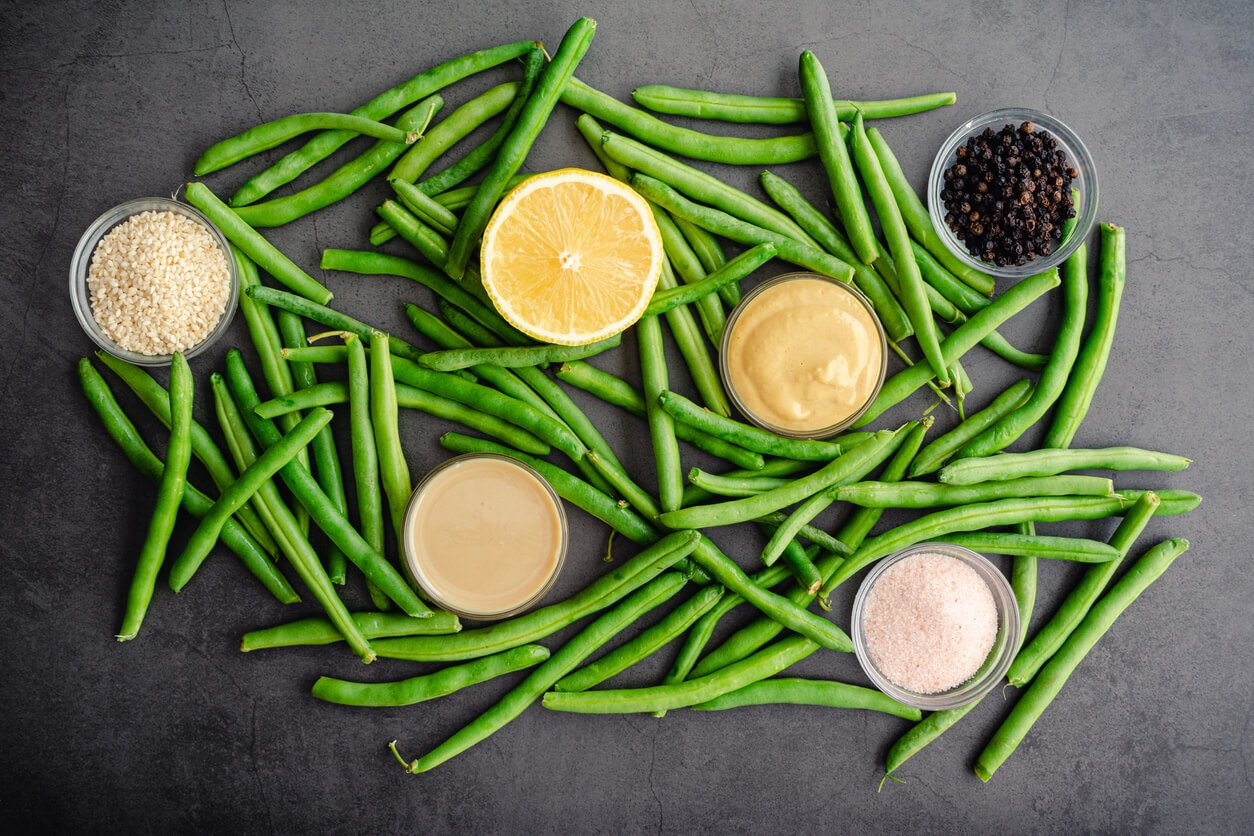
Green beans go well with savory, umami ingredients like mushrooms, onions, and nuts. On the other side of the spectrum, green beans pair beautifully with bright, citrusy flavors like lemon and orange for a different kind of taste bud treat. Here are a bunch of seasoning ideas for your green beans (did I mention that they’re versatile?):
- Fresh garlic or garlic powder
- Olive oil
- Chili flakes
- Balsamic vinegar
- Soy sauce, tamari, or coconut aminos
- Creamy vegan sauces (like a tzatziki or lime jalapeño sauce)
- Herbs and spices
- Black pepper
- Nutritional yeast
- Lemon juice or other citrus
- Maple syrup
- Liquid smoke or combine with a vegan bacon
- Miso
- Salad dressings
Healthy Green Bean Recipes
Fall in love with green beans in the recipes below. You’ll find green bean recipes for dinner, green bean sides, crowd-pleasing green bean recipes, and alternatives to green bean casserole, that American Thanksgiving holiday favorite!
The Green Bean Salad with Vegan Feta is a refreshing dish with lots of crispy, crunchy, and creamy textures to satisfy the palate. The Sautéed Garlic Green Beans are proof that those two ingredients were made for each other. Another match made in heaven: the Green Beans Almondine might just become a new holiday favorite.
Are your friends and family not convinced that green beans can be fun and delicious? Invite them over for our version of the traditional Green Bean Casserole — we promise, they’ll quickly become forever fans! Expand your Italian culinary skills by making the Braised Green Beans Puttanesca, practice your one-sheet baking skills with the One Sheet Spicy Almond Tofu and Green Beans, and feel like you’re dining out when you make the Garlic Ginger Veggie Stir-Fry (with green beans as the veggie star of the show!). Make sure to let us know which which recipe using green beans is your favorite!
1. Green Bean Salad with Vegan Feta
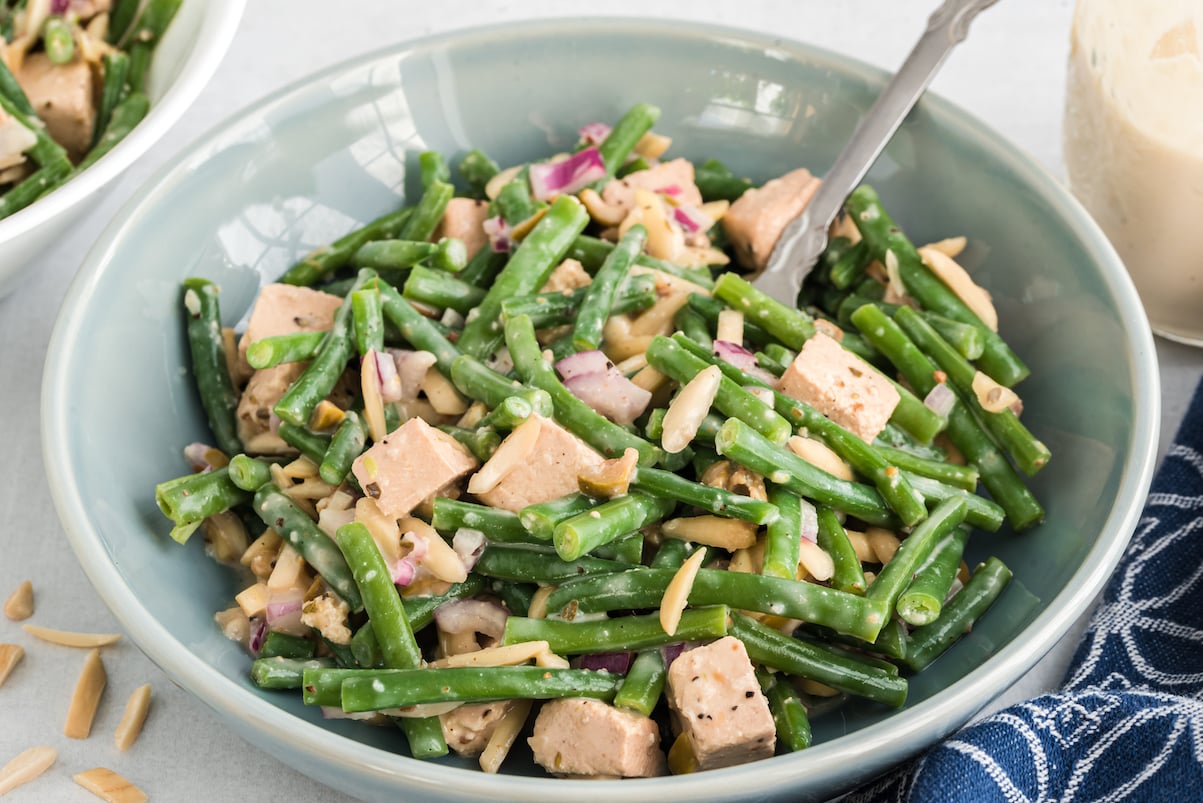
Crispy green beans and crunchy almonds meet soft vegan feta and creamy lemon vinaigrette for a unique and satisfying salad that will appeal to all of your senses. Pro tip: Plan ahead to allow the salad to marinate 24–48 hours before enjoying. The flavors get more intense and delightful with each additional day!
2. Sautéed Garlic Green Beans
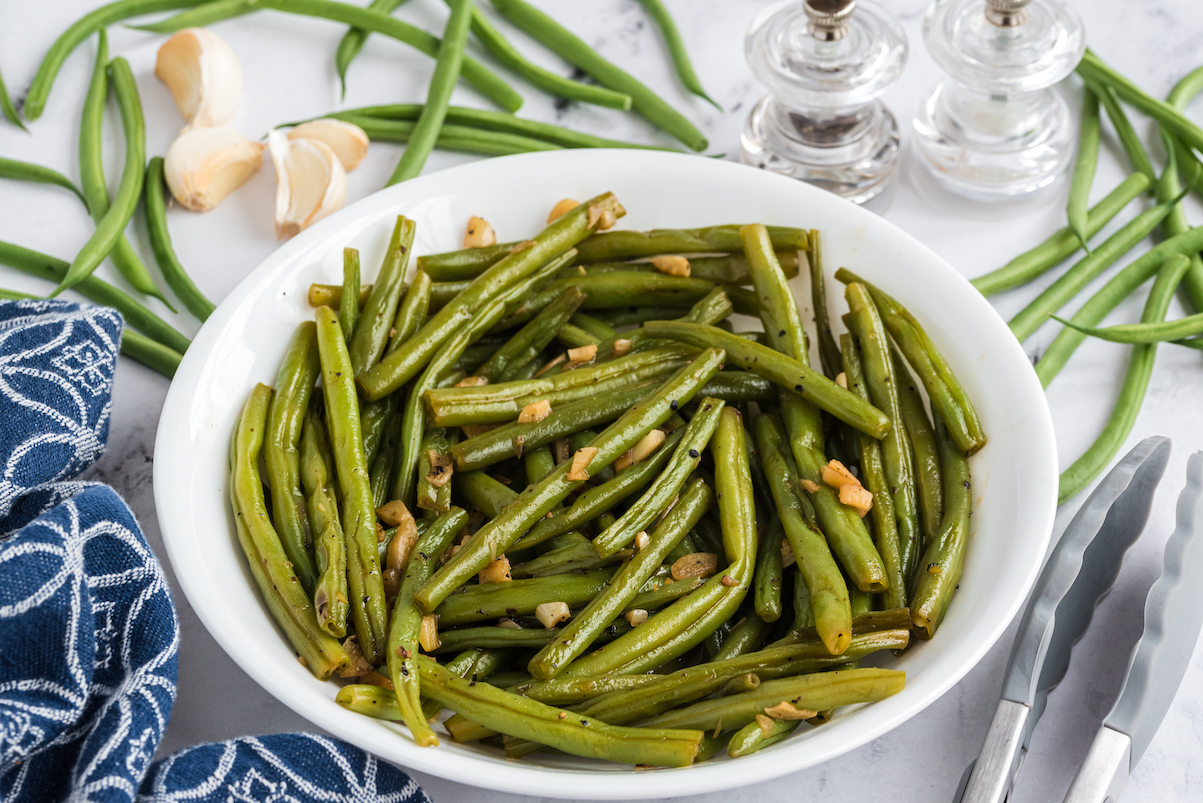
Green beans and garlic go together like, well, green beans and garlic! This easy green bean recipe requires little preparation, comes together quickly, and is simple — yet tastes exquisite. Sautéed Garlic Green Beans are delicious chilled and served as a fresh summer dish or served warm alongside other dishes as part of a festive fall feast.
3. Green Beans Almondine
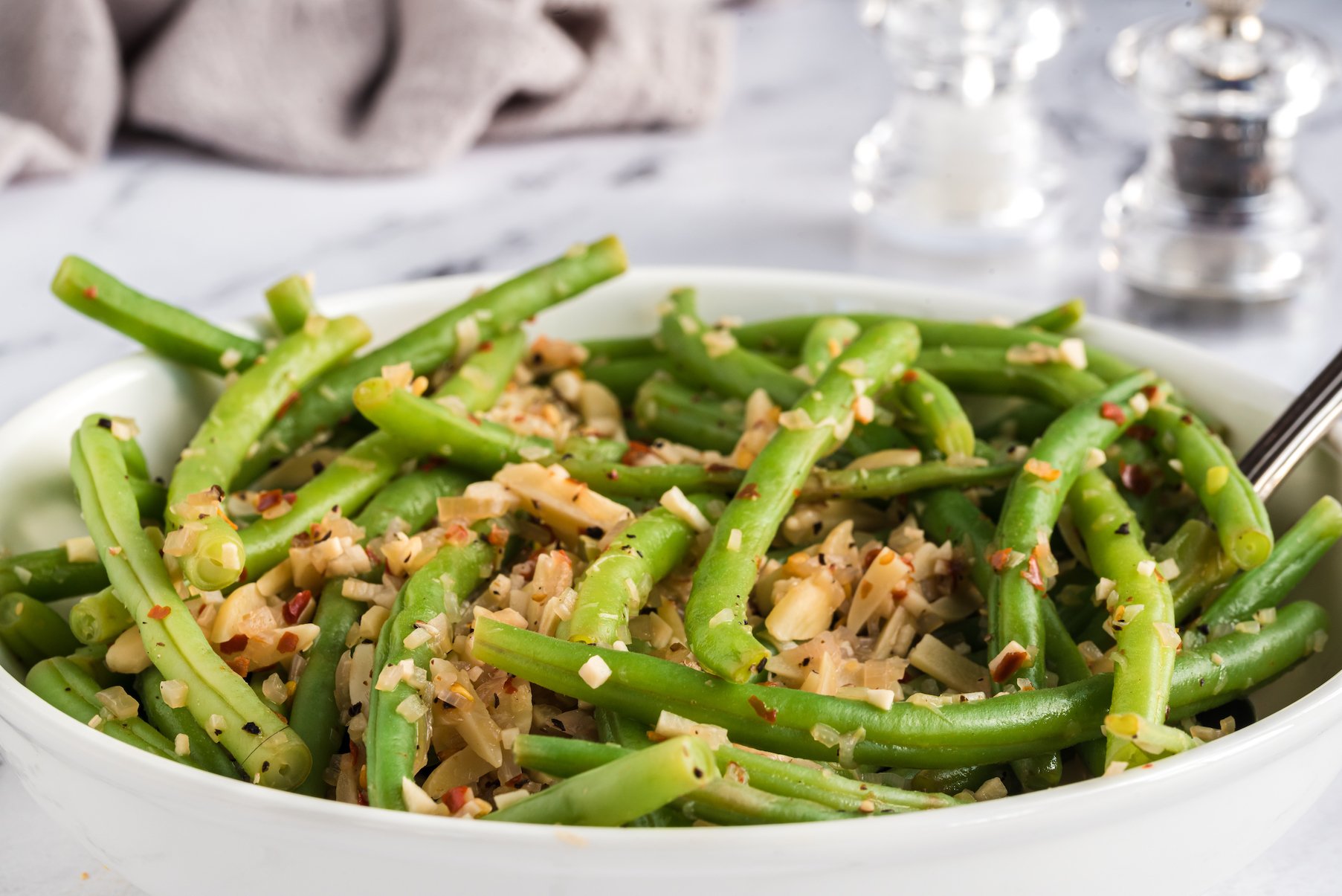
This classic dish is typically made with green beans tossed with toasted almonds in butter or oil. We’ve given it a healthy facelift by omitting the less desirable ingredients while keeping the health-promoting green beans and almonds in this basic green bean recipe, and adding shallots and garlic for more flavor and nutritional value. Bon appetit!
4. Green Bean Casserole
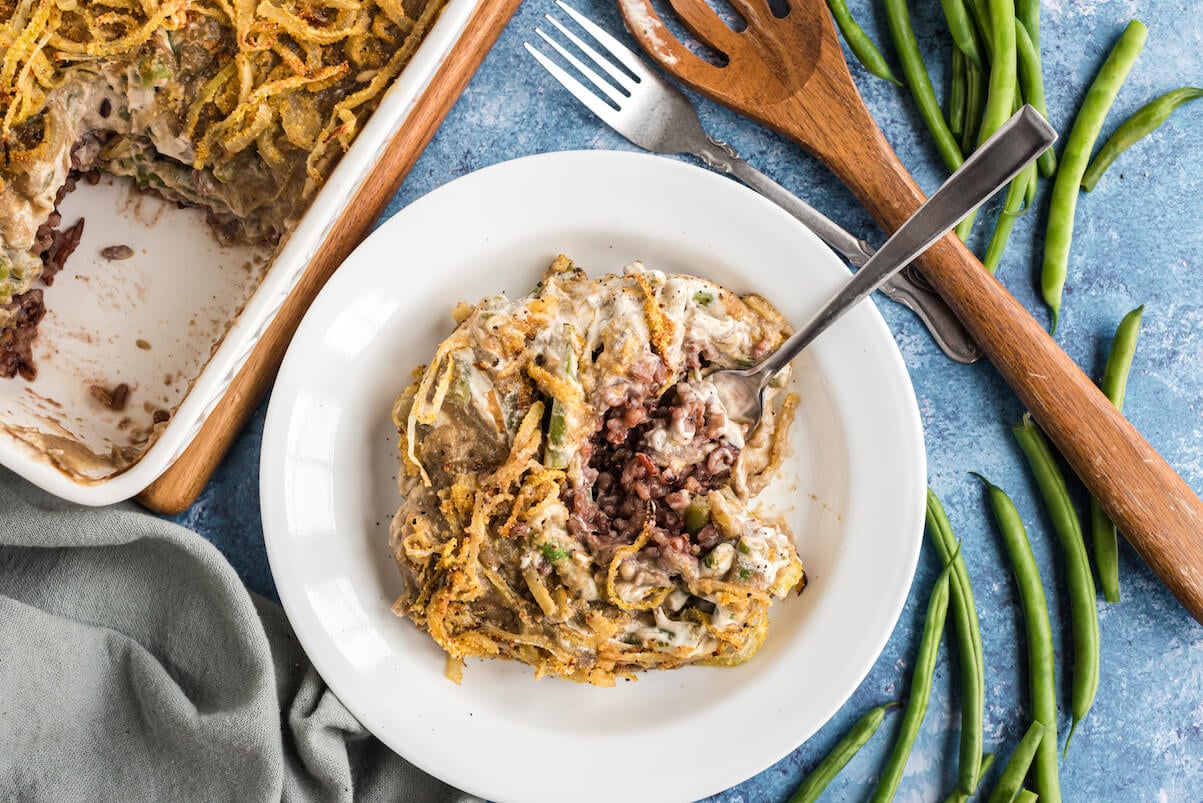
Looking for green bean recipes for a crowd? Full disclosure — this dish includes multiple steps and ingredients, but, trust us, the end result is absolutely worth it! Green Bean Casserole is seemingly indulgent, but loaded with nutrition thanks to the mushroom and cauliflower gravy, cashew sour cream, and baked (not fried!) crispy onions. And the green beans, of course! (Yes, this is a dairy-free green bean casserole!)
5. Braised Green Beans Puttanesca
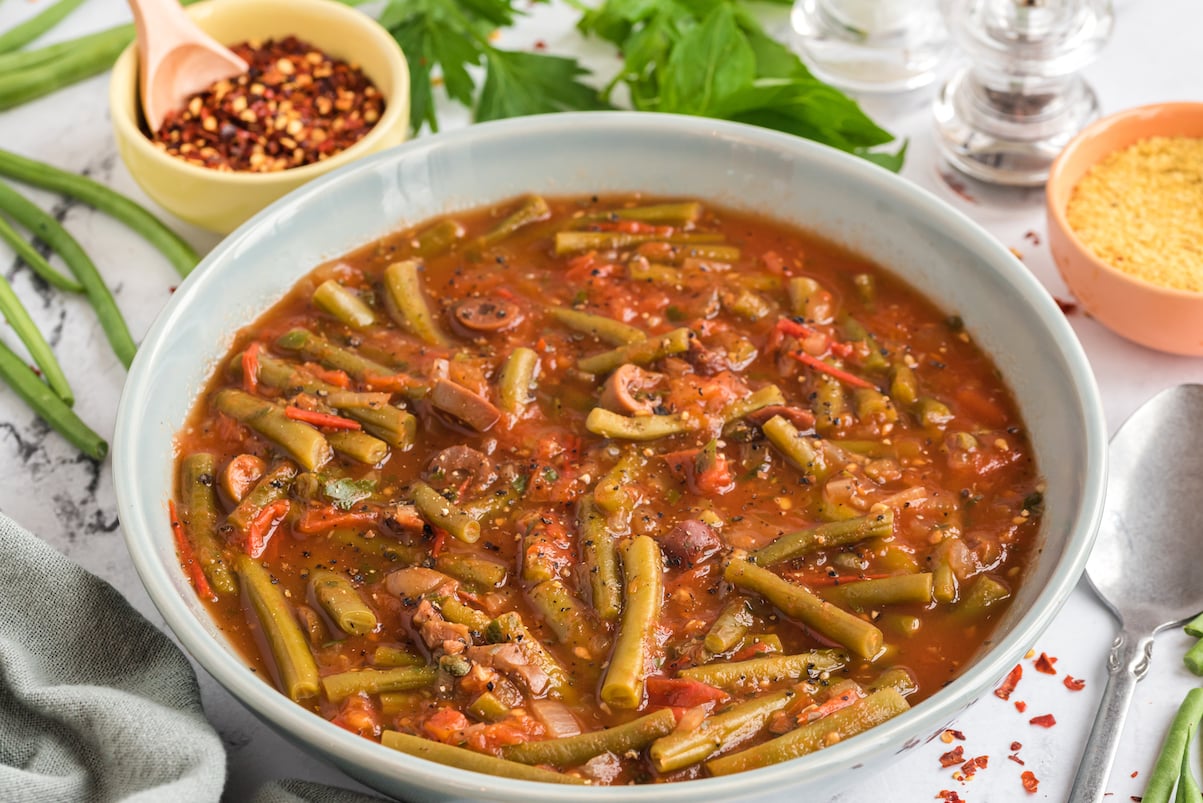
If you’re a fan of Italian cuisine and trying to incorporate more veggies onto your plate, then look no further than Braised Green Beans Puttanesca. This fancy green bean recipe is bursting with flavor from the aromatics (onion and garlic) and umami essence (tomatoes and olives), as well as texture from the crispy green beans. Enjoy this dish as a side or a main meal by topping cooked farro or legume pasta with it.
6. One Sheet Spicy Almond Tofu and Green Beans
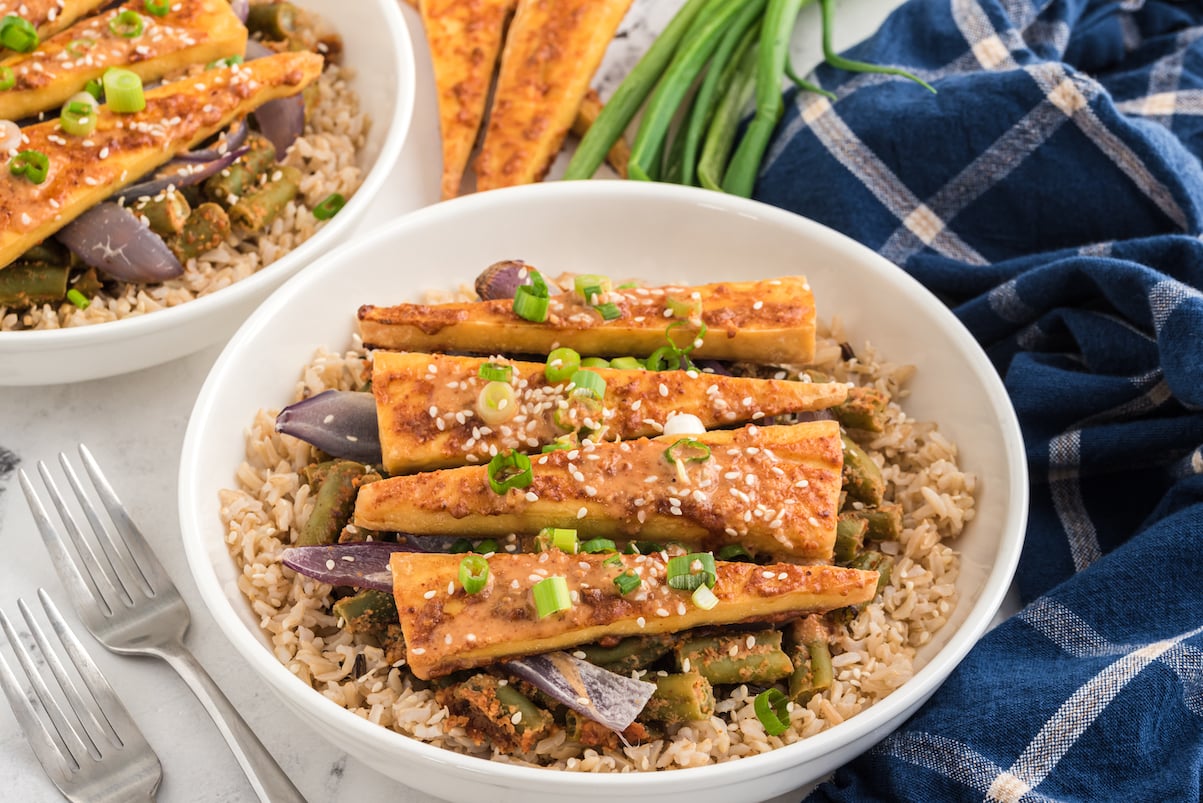
Green beans are brushed with Spicy Almond Sauce before baking alongside onions and tofu for a one (or two) sheet pan dish that is efficient and scrumptious. Once the tofu, onions, and green beans are done baking, you’ll pile them on top of a bed of organic quinoa (or your favorite whole grain), drizzle more sauce on top, and garnish with more flavors and textures for a restaurant-worthy sheet pan meal!
7. Garlic Ginger Veggie Stir-Fry

Impress family and friends with this (oil-free!) restaurant-style garlic ginger stir-fry that comes together quickly and easily. Seasoned green beans, carrots, and onions create an inviting array of colors along with lots of nutrition like fiber, vitamin A, and vitamin C. Enjoy this dish alongside a main meal or make it an entrée by adding it to a bed of your favorite whole grains.
Now You Know What to Do with Green Beans!
Green beans are awesome vegetables: highly nutritious and surprisingly versatile. And despite their association with unhealthy Thanksgiving recipes, you don’t need to drown them in condensed soup or shower them with bacon to enjoy their flavor and texture. With some creative seasoning, al dente cooking, and new ways of eating them, you can transform green beans into a memorable and maybe even favorite food to eat any time of year. Never again will you view them with boredom and mutter, “Bean there, done that.”
Tell us in the comments:
- What’s your favorite green bean dish?
- Have you ever grown beans in a garden? What were your favorite varieties?
- What new green bean dish or technique will you try next?

